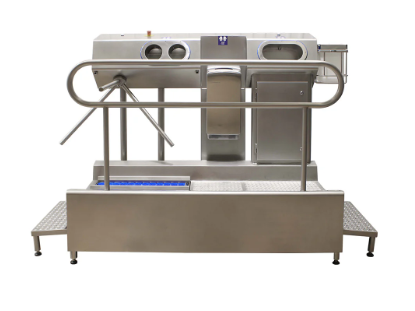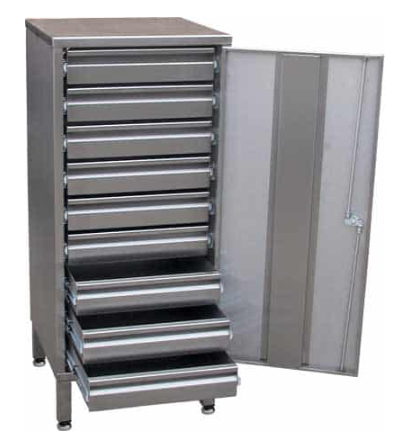Sanitisation is a fundamental aspect of the hygiene process for the food sector to ensure that they remain audit-ready every-day. In order to prevent cross-contamination and enhance workplace safety, this hygienic focus should begin with staff before they enter their hygienic workplace environment.
By enforcing strict hygiene protocols, employers can reduce the risk of external contaminants entering zones where hygiene is imperative. We offer a range of hygiene stations and boot washers as a solution to maintain health and safety standards across various environments.
The importance of sanitisation and sterilisation
Preventing cross-contamination via preparatory staff cleaning processes
Why are hygiene stations best practice for staff cleaning flows?
Hygiene stations provide an intuitive one step process to the gowning and changing room flow by combining hand sanitisation and sole washing in one tidy package. This automated equipment removes the possibility of human error and ensures that each staff member is suitably sanitised before exiting through the turnstile.

Without this equipment, employers cannot be certain that all staff members are equally and effectively sanitised and have washed their hands, creating the opportunity for cross-contamination and bacterial spread to occur. These stations create a hygienic, time-efficient solution with operatives being able to wash both hands and feet simultaneously in what could otherwise be seen as a time-consuming process. In fact, with the use of hygiene stations, up to 15 operatives are able to progress through the station in one minute (depending on the hygiene station used).
Apron washers and boot washers are also available to suit your cleaning environment. Designed for hygiene-conscious industries, the boot washers can remove dirt and debris from the soles and sides of both high and low boots for the highest level of hygiene. It can also be customised with adjustable cleaning times and liquid amounts for a tailored approach to your workflow.
Where should you best place this hygienic equipment?
For hygiene stations and boot washers to work most efficiently, they should be positioned at any high-traffic entry points to the controlled environment before proceeding to a PPE station to pick up the relevant protective equipment. PPE dispensing and disposal stations should also be located throughout the facility.
What maintenance does this equipment need?
To ensure that this hygienic equipment is working optimally, it should be regularly inspected between hygiene flows and kept fully stocked with the relevant disinfectants. This will make sure that every staff member is sanitised to the same level with the correct quantity of cleaning agent.
For best practice, companies should always have a spare set of brushes to hand for times when the brushes are removed and cleaned. Replacement brushes are available on our website for both the hygiene stations and boot washers.
Sterilising equipment to eradicate germs and bacteria

Autoclave sterilisation
Many types of stainless steel furniture and equipment, such as our autoclavable seating and safety matting, can be sterilised using an autoclave. While we don’t sell autoclaves, we can make bespoke versions of our stainless steel furniture and equipment that is autoclavable. Our Teknomexperts will discuss your product needs and create a new variation of our hygienic designs using carefully selected runners, castors, hinges and locks that can endure high temperatures.
An autoclave is a device which sterilises items by subjecting them to high-pressure saturated steam at high temperatures for a specific duration. This method is widely used in medical and laboratory environments to ensure the eradication of bacteria, viruses, fungi, and spores.
The autoclave process
Loading: Items are placed in the autoclave, ensuring proper spacing for steam circulation.
Air is removed: Air is removed from the chamber using gravity displacement, pre-vacuum, or steam-flush methods.
Sterilisation: The chamber is filled with steam at a temperature typically ranging from 121°C to 134°C and pressurised (usually around 15 to 30 psi) for a set time.
Exhaust: Steam is vented out, and the chamber is depressurised.
Drying: Items are dried within the chamber to prevent contamination during removal.
What are the benefits of using an autoclave?
This method of sterilisation is often preferred over the use of chemical agents due to its high effectiveness and lack of environmental impact. The high-pressure steam can kill a wide spectrum of microorganisms making it a better choice than many chemical agents. This steam can also infiltrate porous materials for a more thorough cleaning process.
By relying on just water and heat, you can be certain that there is no potentially harmful residue left behind. There is also no hazardous waste left to dispose of. This eliminates the need to handle dangerous chemicals as part of the cleaning process with a reduced risk of exposure to toxic, corrosive or carcinogenic substances.
How can Teknomek help?
The sanitisation process is a crucial aspect of hygienic environments, but it is not just restricted to the cleaning process of the equipment, the staff can easily cause cross-contamination and the spread of bacteria without a focus on hygiene culture. The use of our hygienic equipment, such as our hygiene stations and boot washers, maintains an emphasis on hygiene and reduces the chance of human error or staff negligence via the implementation of an automated process.
The sterilisation of autoclavable equipment could be explored as a safer and environmental alternative to the use of cleaning chemicals, depending on the type and size of furniture. This offers environmental benefits without compromising on effectiveness.
Want to find out more about how our hygienic equipment can speed up your hygiene flows?
Please call 1603 788833 to speak to one of our Teknomek experts.
